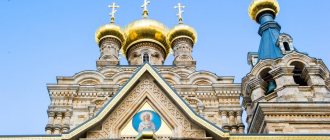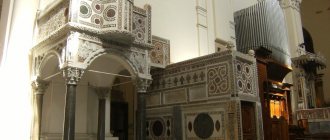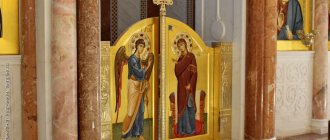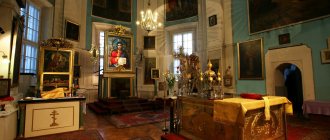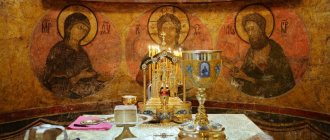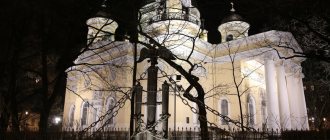Design features
Since ancient times, in Christian carvings there has been an image of the cross, as well as symbolic images: chrisma (monogram of the Savior - the abbreviated name of God), a grapevine (a reminder of the Savior’s Sacrifice and the Eucharist), a peacock (a symbol of rebirth for Eternal life in the Kingdom of Heaven).
Already in the 4th century. churches were decorated with sacred images: this is evidenced, for example, by the letter of St. Basil the Great to Emperor Julian the Apostate, in which he reports that “ the images of the apostles and martyrs... you see in all our churches
" Undoubtedly, these were frescoes that were already present in the catacombs of the first Christians, but probably also icons - after all, the appearance of the first images is attributed by Sacred Tradition to the time of the earthly life of the Savior.
Guess the riddle:
Once upon a time there lived an animal with the letter y, A hippopotamus with the letter b was cleaning its muzzle, A rooster with the letter p, A crocodile with the letter k, And a boar with the letter k. Platypus with the letter y, What kind of animal with the letter y? Show answer>>
Once upon a time there lived an orphan girl in a thicket; she had only two kittens, two puppies, three parrots, a turtle and a hamster with a hamster who was supposed to give birth to 7 hamsters. The girl went to get food. She goes through the forest, field, forest, field, field, forest, forest, field. She came to the store, but there was no food there. It goes further, through the forest, forest, field, field, forest, field, forest, field, forest, field, field, forest. And the girl fell into the hole. If she gets out, dad will die. If she stays there, mom will die. You can't dig a tunnel. What should she do? Show answer>>
Three friends lived in the forest: Deaf, Mute, and Blind. All was good. But somehow Deaf died. Now how will the Mute tell the Blind that their Deaf friend has died? Show answer>>
From the history
The ancient historian Eusebius of Caesarea (c. 260–340) testifies that in the temple, which was erected in his time in the Phoenician city of Tyre, the altar was separated from the rest of the space by a carved wooden fence, which did not allow the laity to approach the throne and was very beautiful. Most likely, this fence was not high and did not hide what was happening at the altar from the eyes of the parishioners.
The same Eusebius of Caesarea tells us that in the Church of the Holy Sepulcher “ the semicircle of the apse was surrounded by as many columns as there were apostles
“- as we see, here the altar barrier did not even represent a single whole.
Contemporary evidence has been preserved about what the altar barrier of the Church of Sophia of Constantinople, created in the 6th century AD, looked like. The court poet Pavel Silentiary described the decoration of the St. Sophia Cathedral in the poetic work “Ekphrasis of Hagia Sophia.” It is obvious that the magnificent iconostasis of the main temple of the Byzantine Empire became a prototype for the decoration of many other churches of its own and subsequent times.
The altar barrier of the St. Sophia Cathedral consisted of 12 columns, which were lined with silver and connected at the bottom with silver slabs, and at the top with an architrave. “ On the tops of the pillars, the hardworking hand (of the artist), with the help of a chisel, carved out the elliptical heads. Among them is an image of the Most Pure God...
» On the architrave connecting the columns, in round medallions with a diameter of about 40 cm, images of the Savior, the Blessed Virgin Mary, angels, prophets and apostles were placed. As we can see, the list of icons practically coincides with the canonical content of later iconostases. Researchers suggest that these images were created using the same technique as the image of Christ: they were executed in relief on silver using the chasing method, followed by processing with a chisel. The altar barrier was complemented by a precious curtain on which was woven the image of the Savior. The iconostasis had the Royal and Deacon's doors.
The altar partition (კანკელი) is part of the interior of a Christian church in Eastern Orthodoxy, which performs approximately the same functions as the iconostasis. A person accustomed to Russian Christian culture usually calls the altar partition an iconostasis, which is not entirely true, although they have a lot in common. Altar partitions were characteristic of churches in Byzantium, the Middle East and Transcaucasia, but over time they were replaced in many places by Russian iconostases. In Georgia, the altar-partition renaissance began in the 1990s, which brought this historical artifact back to life.
Altar partition in Zion Cathedral
Story
The first Christian churches, such as the Lateran Cathedral, the Vatican Cathedral and the Church of the Holy Sepulcher, had the appearance of a basilica with an eastern niche, which at first was not fenced off by anything. This principle became common throughout the Christian world of that time. When the Armenian Church fell into schism, it took this tradition with it, preserved it, and follows it to this day. You can go, for example, to the Armenian temple of Nor-Etchmiadzin in Tbilisi, and see this way of decorating an altar niche.
Altar niche of the Nor-Etchmiadzin temple
Very rarely such altar niches, without walls, are found in Georgia. Usually, these are churches where the partition was dismantled and taken to the museum. We see an example of such design in the church of the Old Shuamta monastery, where the partition existed back in the early 1980s:
temple in Old Shuamta
They write that occasionally the altar niche was fenced off with something like a lattice or low fence. And then came the 5th century. In this century, Eastern Christianity began to believe that the Christian temple should be similar to the Tabernacle of the Covenant, as described in the book of Exodus. Chapter 26 says this:
31. And thou shalt make a curtain of blue, purple, and scarlet wool, and fine woven linen; Cherubim must be made on it with skillful work;
32. And hang it on four pillars of shittim, overlaid with gold, with hooks of gold, and four sockets of silver;
33. And hang the veil on hooks, and bring in the ark of the testimony there behind the veil; and a veil will separate you from the Holy Place from the Most Holy Place.
Probably in those years they decided that the temple should not be built in any way, but in a certain way, prescribed in the Bible. Now the altar niche became an analogue of the Old Testament Holy of Holies, and the rest of the temple became an analogue of the Sanctuary. They began to fence off the altar niche with pillars, usually four, strictly according to the text, and hang a curtain on the pillars (Greek katapetasma). A little later they came up with the idea of laying timber on top of the pillars. And this tradition lasted for 400 years or so. Surprisingly, in the previously mentioned Shuamta monastery there is this same structure of four pillars.
Interior of Shuamta
The Shuamty partition is recognized as one of the oldest surviving ones. But there are some doubts that she looked exactly like that. There are signs that small stone slabs were placed between these columns. And it is difficult to confidently date this partition. There is another, very similar one, dating back to the 9th century, in the Akhalgori region (which is now in South Ossetia) in the village of Armazi.
Temple in Armazi
Art historians consider such a partition to be an example of an early archaic partition. These are still high pillars, between which stone slabs are installed.
This is what the altar niches of Christian churches looked like from the 5th to the 9th centuries. And then iconoclasm appeared in Byzantium, spread, and then was defeated. A fashion arose to place icons between the pillars. This is how the classic arterial partition arose, which can now be seen in almost every Georgian temple. In some places they are also found in the Balkans.
But another intermediate form appeared in Georgia. Around the time of the formation of the unified Georgian kingdom, the partitions changed: now they took the form of a solid stone wall on which stone pillars stood. We now see something similar in the Tskhrakara monastery.
Partition in Tskhrakara
In the same style, but slightly differently, a partition was built in the Khopa monastery (Ksani gorge):
.
Partition in Hopa
During that era, a tradition arose of making partitions from soft stone, for example, alabaster, and decorating them with carvings. Such partitions were not very durable, and almost all died from time to time. The few survivors were taken to museums. For example, the Shuamtin partition looked like this:
Old Shuamta 1962
Following her example, in the 19th century, Grigory Gagarin created the partition of the Zion Cathedral.
Were there icons between these columns? It's a dark matter. At one time in Byzantium they began to paint the upper horizontal beam. Probably in Georgia, for a long time, only this part of the partition was painted. The above partition from Tskhrakar has a painting that looks like this in close-up:
The Greeks called the altar partition templon , and this word passed into some languages, for example, Macedonian, Serbian, Bulgarian, and into Russian in the form of the already forgotten word tyablo . In Georgia they called it kankeli . True, the word iconostasis .
Around the 15th century in the Muscovite kingdom they decided to add another one to the bottom row of icons. Then another one, and in the end there were five of them, and the altar partition rose to the vault of the temple and began to be called the iconostasis. The same fashion came to Georgia in the 16th century, but it manifested itself differently: partitions began to be built in the form of blank high walls. One of the earliest partitions of this type is considered to be the partition in the Akura temple in Kakheti:
Akura Temple
Some art historians believe that it was this mutation of the 16th century that killed the kankel, turning it into a banal iconostasis. And since many elements of its culture died out in Georgia in the 15th century, the extinction of the kankeli at least fits into the logic of events.
In the 17th century, Baroque culture came to Russia, and iconostases began to be decorated with gilded carvings. Around 1795, this tradition spread beyond the Caucasus and led to the creation of a Russian-style iconostasis in the Assumption Cathedral of Ananuri Castle.
Iconostasis of the Assumption Church
In 1640, Moscow ambassadors Fyodor and Andrey visited the cathedral of the Alaverdi monastery, and they were immediately struck by the absence of an iconostasis: “And the altar with the church is not fenced off; instead of a barrier and instead of local images, they are hung with kizilbash stones and knockouts, and instead of royal doors there are curtains, gilded on worm-colored earth.” This description mentions damask (silk fabric), embossing (chintz) and worm color (crimson).
After 1801, the tradition of the iconostasis, together with the Russian army, came to Georgia in earnest and for a long time. In the 19th century, many Georgian churches were redesigned from the inside according to the Russian model. About the same thing happened around, in the Balkans, in Istanbul and even in Egypt, only without an army, but simply under influence. Some iconostases from that era have survived: for example, the iconostasis of 1889 in the Bodbe Monastery.
In the chapel of the Gelati Monastery, the partition was not completely changed, but only the upper tier of icons was attached to it. Now this seems to be the only example of such a partial modification:
Gelati
There were also exotic solutions. In 1891, the Metekhi Church was renovated, in which a partition was made that seemed to be in a very ancient style, with columns without walls, but the Baroque crept into the minds of these people and they entwined the pillars with carved stone vines.
Metekhi Cathedral
Then the Soviet government came, which had little interest in church interiors.
And in 1989, the churches were returned to the communities, and the process of restoring the temples began. Probably that year some partitions were dismantled and taken to museums. Not everyone had enough money for new ones. Even in 2021, in some churches we see temporary plywood altar partitions. But in the main temples new, stone walls with a very different number of pillars appeared. Some of the ancient stuff is missing: some of the partitions we see in photographs from the 1920s, but they were no longer found in the 1960s.
Modernity
In modern Georgia, in most cases you will see newly made altar partitions, occasionally reconstructed, and very rarely original ones that survived from previous eras. Sometimes such partitions are primitive and clearly temporary; for example, in the famous Jvari temple the kankeli is wooden, without any decorations. And in the temple of the Martkopi monastery it is also wooden, but with decorations in the form of carvings. In the very distant, bearish corners of the country you can see clearly ancient kankels in the form of a stone wall, without any pillars or arches. Probably the most accessible of them is in the Zedazeni Monastery.
In the rarest cases, kankels with wooden beams in the Byzantine style have survived. The most typical example: the partition in the temple of the Ubisi monastery:
Altaranya partition in Ubisi
The most common is a stone wall with stylization for the era of the Golden Age, that is, with ornaments of that era, with carved grape leaves and other elements borrowed from the temple decor of that era. In the Zion Cathedral in Tbilisi you can see a typical example of such a kankel.
Below is a whole collection of photographs of altar screens from different regions.
| Kintsvisi | Zedazeni | Pitareti | Gori Cathedral |
| Timotesubani | Martkopi | Chkondidi | Tsugrugasheni |
| Nikozi | Dusheti Cathedral | Tsr. All Saints | arch. Gabriel (Chug) |
| Green Monastery | Khirsa | St. George (Sighnaghi) | St. Nina (Bodbe) |
| St. George (Gelati) | Tsalenjikha | Nikortsminda | St. George (Kutaisi) |
In some places, wooden iconostases from the imperial era have survived. The iconostasis of the Assumption Church in Ananuri Castle has already been mentioned above. In the Bodbe Monastery, a very complex, baroque-type, foreign structure of the late 19th century has survived. And in the Rachin Mountains there is the Barakoni Temple with a completely full-fledged multi-tiered iconostasis of an unknown era.
Iconostasis
Among the exotic options, one can name the kankels in the Aten Zion Temple, where some temporary photo wallpaper was installed during the renovation. From a distance it looks like a real stone.
Aten Zion
Here it should be noted that with all the variety of altar barriers in Georgia, they all boil down to approximately the same type. In Byzantium in the 11th - 13th centuries there was much more diversity. In addition, Byzantine templons rarely had the appearance of arches. More often they looked like a thick horizontal beam on pillars. The emphasis was on the horizontal beam with decorations. So modern Georgian kankels are not exactly the same as Byzantine templons.
Studying
Art historians have been eyeing the kankel since the 19th century, and in 1962, art critic Renee Shmerling published an entire book on this topic: “Small Forms in the Architecture of Medieval Georgia.”
Partition or iconostasis?
The question of the correct name is very confusing. Modern Georgian kankeli is a cross between early partitions without icons and modern Russian iconostases. From the moment icons appeared on the partition, the Greeks began to call this structure an iconostasis, although it is not clear what meaning they put into it. It seems that the difference here is not so much technical as psychological. For the Greeks, the templon was an independent artistic artifact, a work of art with a self-sufficient aesthetic. In Russia, the iconostasis consists of icons and a frame. If you remove the icons, there will be almost nothing aesthetic left. That is, the iconostasis does not exist outside of icons. “The Greeks loved their templons so much that they did not perceive them as mere stands for icons,” wrote one art critic. Thus, by calling the kankel with the word “iconostasis,” you seem to slightly devalue it, shifting the emphasis to its functionality. Although from a linguistic point of view this is not a mistake.
Rene Shmerling differentiated these concepts differently: according to her system, a low wall with columns, allowing one to see the space of the altar niche, is a partition. And the high stone wall hiding what is happening in the niche is an iconostasis.
Ideological battles
In Georgia, the interior issue was resolved simply: iconostases were felt to be a tradition brought in from outside, and they began to get rid of them at the first opportunity in the 1990s. And this process did not cause controversy. An interesting thing happened in Russia, where at some point interest arose in the traditions of the early church and in some places altar niches were made in churches without iconostases. This immediately caused protests at all levels of the church hierarchy, and this idea was called renovationism, betrayal of the church, etc. Large detailed articles were written about how there is nothing superfluous in the temple, every detail is very important and nothing should be abandoned. The authors emphasized that the iconostasis has enormous symbolic meaning. However, they did not explain why symbolic meanings are needed at all. Christianity is valuable precisely because its symbolism is secondary and not obligatory. In terms of the amount of symbolism, paganism had no equal, especially in the era of the Apostle Paul, when Christianity had no symbolism at all. But it was not symbolism that won.
It is interesting that against the backdrop of these battles, the appearance of a Georgian altar partition in the Church of the Shestakov Icon of the Mother of God of the Georgian parish in St. Petersburg, which belongs to the St. Petersburg Diocese of the Russian Orthodox Church, went unnoticed. She appeared there around 2002. And no one cared.
Prerequisites for the formation of the altar barrier
The appearance of the iconostasis had three reasons. According to historians, in ancient public buildings, which were basilicas, like Christian churches, the places of officials were separated from the places of visitors by a low grille. This tradition probably influenced the church decoration.
According to Church Tradition, the introduction of the altar barrier into the canon of temple decoration is associated with the instructions of St. Basil the Great,
who made sure that the altar servers were not distracted from prayer by what was happening among the parishioners.
This barrier was supplemented by a curtain that was drawn and opened at certain moments of the service.
Let us recall that the curtain was also present in the Old Testament temple, where it made the interior of the Holy of Holies invisible to the eyes of the uninitiated. Obviously, it became the prototype of the iconostases that appeared in the churches of the New Testament.
Other meanings of this word:
- "exhibition" of holy paintings
- "honor board" in the church
- "set" of holy faces
- "Exemplary" wall in the temple
- "decorative" wall in the church
- (Greek eikon - icon and stasis - standing place) partition separating the altar from the middle part of the temple
- An altar partition, more or less continuous, from the northern to the southern wall of the temple, consisting of one or several rows of orderly placed icons, separating the altar part of the Orthodox church from the rest of the room
- altar barrier, more or less high, a wall made up of several rows of icons, a barrier between the altar and the main part of the temple, located on the salt
- translated from Greek, this word means “standing of images”, and at the end we can find a diminutive male name
- Translated from Greek, this word means “standing of images,” and at the end we can find a diminutive male name. name this word
- To the right in the temple there is a wall separating the altar and set up. icons
- In an Orthodox church, the wall separating the altar and lined with icons
- gallery of holy paintings
- separates the altar
- Partition with icons in an Orthodox church
- partition with faces at the altar
- Partition separating the altar and the middle part of the temple
- wall covered with icons
- Wall covered with icons separating the altar in an Orthodox church
- Wall covered with faces
- The topmost is the forefathers' rank, below is the prophetic rank, the middle rank is the festive rank, the fourth from the top is the Deesis rank and the lowest is the local rank. What is it all called together?
- Wall with icons
- wall with images
- Wall with images in the temple
- Wall with images in the church
- A wall with a row of icons separating the altar from the rest of the Orthodox church
- wall with holy paintings
- Wall separating the altar
- wall, temple decoration
- Church "art gallery"
- church "stand" with holy paintings
- Orthodox church element
